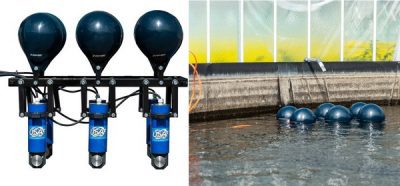"Amazing that risks are still being taken with basin and cultivation water"
Basin water is generally mixed with drain water untreated, i.e. without disinfection. All pathogens found in
are thus sent directly into the greenhouse. Robert de Hoo and Kees Luykx, distributor and producer of USAF
ultrasonic transmitters, are amazed by this.
Robert: "We can actually say that there is often a lack of insight into the quality of the basin water used. The drain water is
However, it is estimated that this does not happen, or barely happens, in the case of basin water.
He points to practical examples. "Recently, the Tomato brown rugose fruit virus (ToBRFV) was found in a tomato grower in Belgium.
his basin water, while the virus was not (yet) found in the greenhouse. And at a grower in West-Friesland, the virus was found in a whole
In a covered pool (against algae growth), a very high concentration of the Pythium fungus was found. In both cases, the water was
pumped directly into the mixing containers without any form of disinfection. Both growers found out about these contaminations by accident.
Had they used this contaminated water in the greenhouses, this could obviously have resulted in a lot of extra work and large damage costs."

Both companies contacted Ultramins in response to earlier articles on GroentenNieuws. Ultramins is
exclusive distributor of the USAF ultrasonic transmitters that combat microorganisms in basin and silo water.
Robert: "We were approached whether our USAF ultrasonic transmitters could provide a solution and of course we can. However
we are surprised that growers are still prepared to use basin water at the drop of a hat. Various strict and costly
Measures are taken to work as safely as possible. For example, no visitors are allowed in the greenhouse, shoes are not used, and the
decontaminated, protective clothing is worn and tools are often decontaminated. Laboratories can use the
If you can tell from water samples what is in the basin water, then you are not going to take any chances with that, are you?
But even if you know the result, it may be different tomorrow, as the basin water is an open system. Basin water can be used on a
relatively easy way and in combination with H2O2 USAF kills more than 99.99% of the micro-organisms.
These transmitters operate 24/7 at low operational costs, require no maintenance, are environmentally friendly and deliver the best
result."
Testing
Tests with ToBRFV-infected water, recently carried out by Proeftuin Ron Peters, showed that virus in the water infects
of the plants. (read the article about the test here) So these are risks that growers should not be willing to take, according to
Robert. "However, there is often still traditional thinking: 'This is how we have always done it, never before has the basin water been disinfected'. While
In fact, every grower knows that there are plenty of dangers in this water stream, especially when there are other growers or arable farmers in the area.
are active in the neighbourhood."
Kees Luijkx, producer of USAF: "We are sure that when all the water is disinfected by USAF the yield will improve and the
loss will decrease. Every grower knows that cleaner cultivation water leads to higher yields. It is therefore surprising that there are still
Risks are still being taken with basin and cultivation water. The risks that are taken now can easily lead to enormous
losses, which could easily have been avoided. Suppose that this method of decontamination would have resulted in an additional yield
brings in just 1 to 2%, then any investment is quickly recouped."
Source: www.groentennieuws.nl
Click here to go to the original article.
Publication date: 15 December 2021
For more information:
Ultramins
De Corantijn 87a
1689 AN Zwaag
+31 (0) 620 536 536
+31(0) 85 023 10 97
info@ultramins.com
www.ultramins.com
